The Insider
Election-watching for the people
October 31, 2012
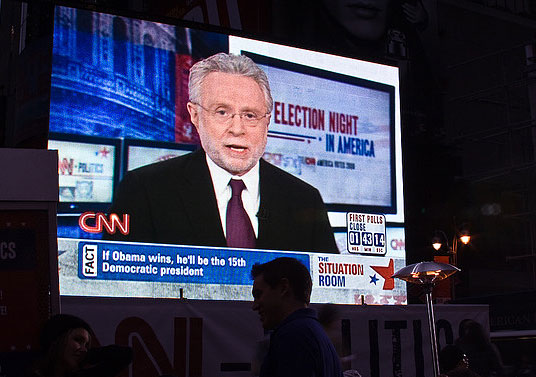
The 2008 big screen scene in N.Y.’s Times Square. Now it’s L.A.’s turn. Photo/Houry Najjarian via Flickr
Why watch the election from your living room when you can tune in from Los Angeles’s newly-remodeled civic core? Grand Park—nestled between City Hall and the County Hall of Administration—is throwing a free Election Night party, and everyone’s invited.
The event is being dubbed “Park Your Politics,” and the park’s director, Lucas Rivera, says it’s a chance to share a sense of history in a way that few people do anymore.
“We as Americans have stopped coming together in moments where we could see and witness something that changes the movement of this country,” said Rivera, adding that sharing the experience could make the outcome more enjoyable (or tolerable, depending on your outlook.)
CNN’s coverage of the 2012 Presidential election will be projected onto a huge 10-foot-by-30-foot inflatable screen, so every detail of Wolf Blitzer’s perfectly-manicured beard will be visible far and wide. While the results trickle in, guests will be entertained by music from KCRW’s Anthony Valadez and Dublab DJs. L.A.’s famed gourmet food trucks will keep hunger at bay and a beer garden will offer refreshments for the celebratory and weary alike.
The party takes place on the performance lawn between Grand Avenue and Hill Street on Tuesday, November 6, from 5 p.m. to 10 p.m. To get there, take Metro Red Line to the Civic Center stop or visit the park’s website for driving directions and parking instructions.
Posted 10/31/12
More than one way to cast a ballot
October 31, 2012
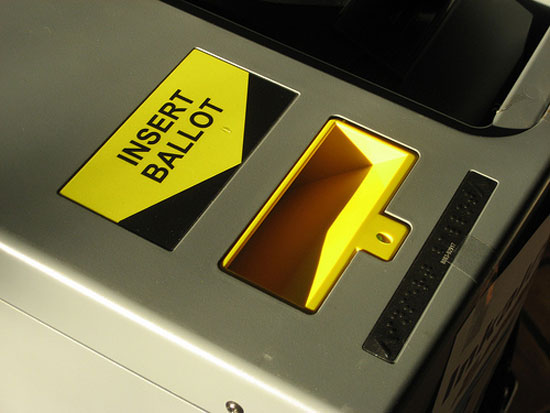
Whether you vote early or push it until right before the polls close, there's a way to make your voice heard.
Voting is not a spectator sport, and there’s no need for Los Angeles County residents to feel left out, even in a battleground-state-obsessed election like this one.
Early voting is getting lots of attention in other parts of the country, and you can do it here, too.
The Los Angeles County Registrar-Recorder’s office in Norwalk is open for early voting now through Election Day, with weekday hours from 8 a.m. to 5 p.m. and this Saturday and Sunday from 8 a.m. to 4 p.m. The address is 12400 Imperial Highway, Norwalk, 90650.
More than 1.2 million county voters requested absentee ballots for this election. If you haven’t mailed yours in yet, be sure to do so by Thursday, November 1; absentee ballots must be received (not just postmarked) by the time polls close on Election Day. If you’re in any doubt about making the deadline, just drop your ballot off in person at any polling place on Election Day.
Polls will be open on Tuesday, November 6, from 7 a.m. to 8 p.m. To find your polling place, go to www.lavote.net or call (800) 815-2666.
You can also check the same website to make sure you’re registered. If you’re one of the thousands who registered right before the deadline, your information may not have been entered into the system yet. Don’t worry! Find your polling place by clicking here, and go ahead and vote.
You will be offered a provisional ballot, which will be counted once your eligibility is verified.
“At this stage of the game, we’re encouraging people to just show up and vote,” said Registrar-Recorder/County Clerk Dean Logan. “If there’s an issue—if there were data entry errors in your form or if it was late getting to us—we can research those issues during the post-election canvass period. But if you don’t show up and vote we can’t fix it.”
He said that 90% of all provisional ballots in California are determined eligible and end up being counted.
Even with a tight presidential race whose outcome is likely to be determined elsewhere, casting a ballot here is vitally important, not only to contribute to the popular vote nationally but also to weigh in on important state and county measures, along with local races. With so many options, there’s really no good excuse not to vote.
“When people say your vote doesn’t count because you’re from California—well, it absolutely does count,” Logan said. “It has meaning and it’s important for you to show up and be counted.”
Posted 10/31/12
The county ballot from ALF to Z
October 4, 2012
When Santa Monica-Malibu Unified School District officials got the word that their upcoming bond measure would be designated FF on the November ballot, they felt like parents confronted with a bad report card.
“FF sounds like double fail,” said school board president Ben Allen. “We’re trying to help kids succeed.”
Fortunately, they were able to get the designation changed to ES, evoking “education” and “schools,” much to the relief of those backing the measure.
“It works great,” Allen said. “You want voters to consider these measures on their merits.”
In a busy presidential election year like this one, with 42 local and 11 statewide measures going before Los Angeles County voters, the ballot could, to the uninitiated, resemble a bowl of alphabet soup. But there’s a method to the distribution of letters.
And requests to change the original designations come in all the time.
“We do get requests from all kinds of jurisdictions in the county, and we get very specific requests,” said Alex Olvera, division manager for election information and preparation for the Registrar-Recorder/County Clerk. “In L.A. County, we always allow jurisdictions to make a 1st, 2nd and 3rd choice.”
“A and B are the most requested,” he said. Some jurisdictions, especially school districts, add a special plea: “Whatever we get, just don’t give us D or F.”
Early planning is helpful. The city of Inglewood, for example, put in its request well in advance to get the letters IT assigned to a 2006 sales tax measure—enabling a successful pitch to “Vote for IT.”
This year, Sierra Madre officials secured a relatively rare three-letter designation, ALF, to go with a measure asking voters to decide whether to allow development of an assisted living facility.
Priority in assigning letters goes to countywide measures. This year, Measure A is an advisory measure that asks voters to consider whether to make the county assessor an appointed position.
Measure B is the so-called Safer Sex in the Adult Film Industry Act, which would require the use of condoms on porn shoots. (And no, county election officials didn’t even consider labeling that one Measure X. That designation is going, instead, to a Pomona measure asking voters to approve a parcel tax to support library services.)
It was the Pomona Unified School District, meanwhile, that drew one of the more regrettable designations for a ballot measure in recent memory.
“We had assigned the measure PU, and it was not endearing to the school district,” Olvera said.
The alternative designation—PS—passed the smell test and was approved by local voters in 2008.
Posted 8/22/12
The grandest opening of them all
October 4, 2012
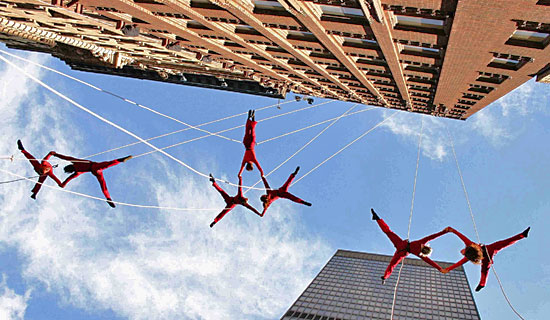
Bandaloop brings its aerial artistry to City Hall on Saturday, for the opening of Grand Park's final segment.
It’s been rolling out, bit by bit, since mid-summer, but this weekend, Grand Park will finally get the grand opening Los Angeles has been waiting for.
As the third and final section of the 12-acre space opens to the public, a festive block party is being planned on Saturday, October 6, from 4 p.m. to 9 p.m., with dancing around the fountain, Cuban jazz on the lawn, food trucks on the street and, at the park’s eastern boundary, a soaring aerial ballet up the sides of L.A.’s iconic City Hall. Then on Sunday, the park will leap into action as a hub for the wildly popular CicLAvia.
“It’s really exciting,” says Dawn McDivitt, who has managed the park project for the county’s Chief Executive Office. “The opening of the first two blocks in July drew 5,000 people in the first weekend, and we think this weekend will draw even more.”
Stretching from City Hall to the Music Center, the new park—an inviting 4-block rectangle of grass, plants, water and hot pink lawn chairs—has been drawing crowds since its first segment opened this summer, offering the first substantial stretch of green space in downtown L.A.
Conceived nearly a decade ago as part of a plan to redevelop Grand Avenue with luxury hotels, condos and retail, the park moved ahead while other elements were postponed by the economic downturn, largely because of a $50 million payment that was negotiated upfront from Related Cos., the project’s developer.
The first section, opened in July, is anchored by a Starbucks and the Arthur J. Will Memorial Fountain, which features an ankle-deep membrane pool that has become a major weekend draw for nearby families. The middle section features a community terrace with a Court of Flags, a Vietnam Memorial and 24 cherry blossom trees from the Japanese Consulate. The final section, at the City Hall end, will offer a dog park and a spacious event lawn that planners already are programming for local gatherings. Also on tap for the future is an anchor restaurant or café at the City Hall end of the park.
“I think if you ask anyone, the park is already a success,” says McDivitt, noting that none of the park events so far have drawn fewer than 200 to 300 people. “And when you compare that to the mall that was there before, where, if you saw 20 people in all three blocks, you were lucky—just looking out my window at the Hall of Administration, it’s amazing. People who have driven in from their communities for events, neighborhood people from the lofts, mothers sitting around the membrane pool with their children. There are more people than I’ve seen down there in 22 years of working here.”
This weekend’s kickoff is expected to draw crowds from throughout the county, starting with 11 a.m. dance lessons at the Music Center Plaza in a salute to Latino Heritage Month.
At 4 p.m., the Grand Park celebration will officially begin with “A Fanfare for Grand Park,” a reprise of a dance performance that premiered at the park’s July dedication.
At 5:30 p.m., down the hill on the park’s performance lawn, the Latin jazz duo Dos y Mas will launch the park’s new World Jazz Series, and at 6:45 p.m. outdoor videos will be projected onto the wall of the county’s Richard Neutra-designed Hall of Records building that flanks the park.
After a welcome from public official and dignitaries, the party will move to the event lawn. There, at 7:45 p.m., the aerial dance troupe Bandaloop will perform a spectacular vertical dance on the walls of the city’s towering City Hall building, suspended hundreds of feet off the ground by climbing ropes.
Park officials view Saturday’s celebration as just the start of Grand Park’s new role as a downtown centerpiece. Programming will be handled for the first three years by the Music Center, and Park Director Lucas Rivera has predicted the park will soon be home to farmers’ markets, arts festivals, book fairs, and other regional gatherings. McDivitt says she won’t be surprised to see regular movie nights, with outdoor films projected on the Hall of Records. Already, one segment of the park is home to the downtown speakers’ series Zócalo.
Events scheduled for the near term include an October 14 Pooch Party for dogs and the people who love them on the event lawn, an October 27 performance by the AXIS contemporary dance company, a November 2 night time Dia De Los Muertos party and a November 4 arts happening called Flash Fest.
Says McDivitt: “This really is a brand new chapter for downtown L.A.”
Posted 10/4/12
Taking Tiny for a ride
September 19, 2012

L.A. County dogs, especially small "fluffies" and Chihuahuas, are finding new homes around the country.
Los Angeles has plenty of big, famous exports: movies, food trends, celebrity gossip.
And at least one sought-after small one: the pint-sized rescue dog.
While dogs in Los Angeles County’s busy urban animal shelters can range from dachshunds to Saint Bernards, there’s an abundance of the little ones coveted by would-be adopters in other areas.
So a thriving pet transport circuit has sprung up. Since 2009, 3,457 L.A. County shelter dogs have found their way to Utah, Oregon, Montana, Colorado, Virginia and New York. Within California, they’ve hit the road for new homes in San Diego and Santa Cruz, with stops along the way at closer, less-crowded shelters in Irvine and Glendale. With 1,219 dogs transported so far this year, 2012 is the busiest yet for county canine relocations.
To land a quick home in another ZIP code, the transplanted L.A. dogs must be healthy, friendly and (generally) small. “Anything under 30 pounds, they’ll take. We could ship 5 Chihuahuas for every Labrador,” said Marcia Mayeda, the county’s director of Animal Care and Control. “It’s filling a void in their area.”
Because of the sheer size of its shelter population and the popularity of certain petite breeds here, Los Angeles County is able to share its canine wealth with places that have a shortage of adoptable small dogs.
The dog-moving operations have been funded by non-profit organizations like Best Friends Animal Society and the Heigl Foundation, established by actress Katherine Heigl.
Now the American Society for the Prevention of Cruelty to Animals is getting in on the act. With funding from New York philanthropist Carroll Petrie, ASPCA aims to save 16,600 dogs across the country in the next 8 months by helping to transport them out of crowded shelters. The Los Angeles County Board of Supervisors this week approved the county’s participation in the Carroll Petrie Foundation Dog Rescue Project. A subsidy of $50 per dog will allow the transfer of some 50 dogs a month from the county’s Downey Animal Care Center to the Mission Viejo Animal Services Department and, potentially, to other shelters as well.
The Chihuahua popularity boom—fostered by rampant media images of well-heeled pooches traveling around in celebutantes’ purses and stealing scenes in movies like Legally Blonde and Beverly Hills Chihuahua—contributed to overbreeding and a tiny-dog population explosion in L.A. and other California shelters in recent years. (On Tuesday, of the 1,521 dogs in Los Angeles County shelters, nearly a quarter—378—were Chihuahuas or Chihuahua mixes.)
Some highly-publicized relocation efforts, such as Project Flying Chihuahuas and Operation Chihuahua, have helped move hundreds of the little pooches from California to new homes around the country.
But now some areas are beginning to contend with a Chihuahua boom of their own, and have had to limit the number they accept.
Portland, for example, is “kind of saturated” with Chihuahuas these days, although the Oregon Humane Society still welcomes a twice-a-month shipment of other kinds of dogs from L.A., said Jennifer Barta, the agency’s “second chance” coordinator.
“Everybody here loves the L.A. dogs,” Barta said, marveling at how the transplanted pups endure “an incredibly long journey” yet still manage to come out wagging. “It’s just pretty phenomenal.”
Robin Harmon, “Pup My Ride” coordinator for the Best Friends group, has a good sense of what kinds of dogs are moving where.
A vanload of dogs that traveled from Los Angeles to Salt Lake City this week was “half Chihuahuas and a half what we call ‘fluffies’—poodle and terrier mixes,” Harmon said.
An upcoming shipment to New York, she said, will “probably have at least 30 Chihuahuas.” One of those L.A. expats will be going to the Hamptons, she said: “We’ve been laughing about that.”
An exception to the small dog rule: Billings, Montana, which Harmon said can be counted on to welcome four or five German Shepherds, along with other smaller dogs, from L.A. every couple of months.
Cats, alas, are another matter. “We are pretty well inundated with homeless cats of our own,” said Jessica Almeida of the Humane Society of Utah.
Even though the transport system can’t solve all the problems of homeless pets, redistributing the adoptable dog population makes it easier for conscientious consumers around the country to do the right thing when it comes to bringing home an animal.
“People want to go to a shelter,” said Mayeda, the county’s Animal Care and Control director. “They want to save a life.”
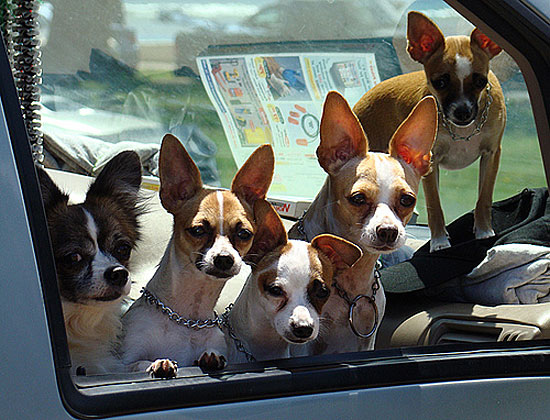
L.A. County shelters have plenty of Chihuahuas to share, but other areas, like Portland, are catching up.
Posted 9/19/12
Long may she wave—o’er Grand Park
September 6, 2012
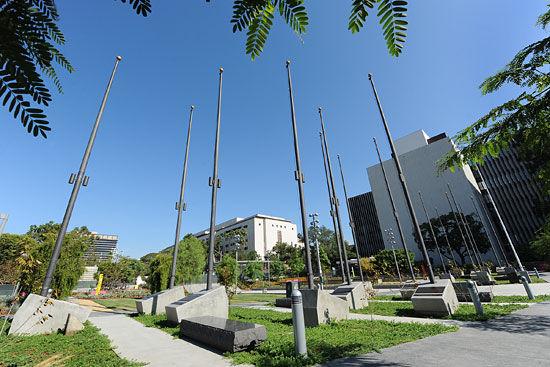
The historic flag court has been moved and positioned for higher visibility and more public space in Grand Park.
The next shiny, new section of Grand Park debuts Tuesday, but its centerpiece has been around for decades—although odds are you’ve never heard of it. Called “The Historic Court of American Flags,” it’s long been flying under the radar.
When the court was first completed in 1971, it featured 18 replica flags dating back to 1774, with plaques describing each one. The minimal landscaping surrounding the display served mostly as a cover for a four-level parking garage below. As far as public visibility, you’d be lucky to see more than a few stars and stripes from the neighboring streets.
Now, as the Grand Park Project gives the 12-acre space between the Music Center and City Hall a dramatic makeover, the flags have been uprooted from their original spot in the center of the park space and arranged parallel to Hill Street and Broadway. This not only vastly opened up the middle of the park’s third block but also gave the flags a more showy location.
Dawn McDivitt, the county’s project manager for Grand Park, said the flag court provides the community with “a space to reflect” on the nation’s—and the county’s—history. She said the county’s Department of Military and Veterans Affairs was consulted on the flags’ relocation and were “very, very pleased” with the results.
The flag court represents an effort by the designers to incorporate the area’s history with its future. A signature feature of the park, in fact, is the renovated Arthur J. Will Memorial Fountain, which, like the flags, was largely invisible to the public until two parking lot ramps were demolished and relocated.
The newest touch was the design of the concrete pedestals in which the poles and plaques have been mounted. Before, everything was cemented at ground level. Architects from Rios Clementi Hale Studios, which designed Grand Park, created the blockish pedestals so that the flags and plaques could be seen more easily, by more people.
The latest section scheduled for opening this week has been dubbed “Community Terrace.” Besides the court of flags, it boasts plants and flowers from all six floristic regions of the world, 24 cherry blossom trees from the Japanese Consulate, and, of course, the park’s movable magenta benches, chairs and tables. Terraced ramps will improve access to the area while offering extra seating capacity for large events once the final segment of the park near City Hall opens on October 6, just in time for the hugely popular CicLAvia to roll through the next day.
The Community Terrace is also home to theVietnam Memorial Monument, which features a bronzed Army helmet from the war’s era. The helmet had been sawed off and stolen twice over the years, so designers upgraded the monument with a threaded steel rod and other security measures to keep any would-be thieves at bay.
The terrace will open with a short ceremony on Tuesday, September 11 at 9 a.m. Bea Cohen, a 102-year-old World War II veteran recently honored by the Board of Supervisors, is expected to be on hand for the event. During the ceremony, the historic flags will be hoisted by veterans from all branches of the military, as well as by fire and law enforcement officials.
Posted 9/6/12
New Counsel lends a steady hand
July 25, 2012
When John F. Krattli started work at the Los Angeles County Counsel’s office, fresh out of law school, his plan was to do a few years there and then move.
“I was so sure that I wasn’t going to be here long-term that when my wife and I needed money to make a down payment on a home in the early 1980s, I pulled out of the county retirement system,” he recalls, chuckling. “I never envisioned things would turn out the way they did.”
This week, Krattli, a 33-year employee of the county, was officially named Los Angeles County Counsel, a job he has unofficially held since early this year. He succeeds Andrea Ordin, who held the post for two years before retiring at the end of January.
“It’s definitely an honor,” he says, “even if it’s not entirely new.’
As the county’s top lawyer, Krattli, 59, will oversee some 520 employees, including 285 attorneys. His salary will be $275,000 a year.
The son of a U.S. Navy commander, he was born in Norfolk,Va., and raised in Japan and San Diego County. He graduated from UC Santa Barbara with a degree in economics, spent a year working at the Stanford Research Institute and then entered the UCLA School of Law.
He was admitted to the State Bar in late November 1978 and started work in the general litigation division of the County Counsel’s office five weeks later. Over the ensuing decades, he would come to oversee at least a half-dozen divisions of the office, and to play a part in some of the most complex municipal litigation in Southern California.
His assignments as a deputy county counsel, for instance, included the massive Big Rock Mesa lawsuit, which was one of the largest inverse condemnation cases in local history. The case stemmed from a 1983 landslide above Pacific Coast Highway in Malibu and lasted some 4 1/2 years before the county, the state and some 240 homeowners reached a settlement.
He also began to rise through the ranks—his initial career plans notwithstanding. He was made chief of the office’s public works division in 1994, and became principal advisor to the Los Angeles County Local Agency Formation Commission, advising LAFCO during the unsuccessful Hollywood, Harbor area and San Fernando Valley secession bids in 2002.
He was promoted again, in 2003, to senior assistant county counsel, and became a member of the Los Angeles County Claims Board the following year.
Along the way, he bought back into the retirement system.
“In fact, I was contemplating retiring myself,” he says laughing.
An avid traveler and father of two, Krattli, who lives in Simi Valley, said he had just started thinking about taking trips with his wife, Kay, a retired Granada Hills schoolteacher, and spending more time with his 1-year-old twin grandsons when Ordin and her chief deputy both announced last year that they would be retiring. By then, Krattli had served under six County Counsels.
Ordin named him Acting Chief Deputy in December, and he has been Acting County Counsel since February 1.
“It wasn’t my intention to become the County Counsel, but I’ve certainly enjoyed the job,” Krattli says. “It’s certainly been challenging. There is never a lack of issues, and the county has great managers to work with. And we have not only just an outstanding group of attorneys and staff, but a very collegial and friendly workplace.”
In fact, he says, one of his great satisfactions on the job stems from the long experience that he and many of his coworkers share with the county, and the knowledge that he is surrounded by steady hands.
“One of our hallmarks in this office is that people like to work here, and that has certainly been to the benefit of the county, because it means that there’s just a tremendous amount of historical knowledge here,” Krattli says.
“There are many people in this office who have worked here for a long time, and who have developed tremendous expertise.”
Now—whether he envisioned it or not—the office will be led by one of them.
Posted 6/6/12
C’mon in, the water’s fine. Really.
July 25, 2012

Dancers splash in the Arthur J. Will fountain's new "membrane pool" during Thursday's dedication ceremony.
It’s big, it’s wet and it’s already making a big splash as the first segment of Los Angeles’ Grand Park opened this week.
The 6,200-square-foot pool in front of the restored Arthur J. Will Memorial Fountain has only a quarter-inch of water, but it’s likely to be a huge crowd magnet, says Jim Garland, president of Fluidity Design Consultants, which oversaw the fountain’s restoration and expansion.
“It’s going to be awesome,” says Garland. “There’s a similar pool around the Millennium Park Fountain in Chicago, and kids roll around in it, and people just love it, and it’s probably the most popular fountain today in the United States.”
But under the sleek, nonslip surface and its inviting jets of water, an elaborate system of machinery and maintenance workers will be hustling around the clock to keep that expanse—technically known as a “membrane pool”—clean. The pool’s filtration system was kept separate from the one used for the fountain itself, Garland says, because health codes set a higher standard of cleanliness for interactive water elements.
Every drop will circulate every half-hour through an underground filtration and disinfection system that will kill bacteria with ultraviolet light and chlorinate the water. Security guards will patrol to ensure that no one abuses the pool area or mistakes it for a bathtub. And the crews that monitor the fountain at the Dorothy Chandler Pavilion will manually test for cleanliness at least three times daily.

Barefoot in the park: Dignitaries like Eli Broad are among the first to take the plunge after Thursday's ribbon-cutting.
“It’s about a 10 minute test—we just take a water sample and drop in a tablet,” says Keith McTague, director of building services and chief engineer at the Music Center. “We’re mainly doing it as a check and balance on the filtration system, which is automatic, and so that the readings are documented. But if we have to do it more often, we will.”
These safeguards are crucial because, while the historic Will Memorial Fountain was designed to keep people out of its waters, the adjacent membrane pool was conceived as a way to entice kids and grown-ups alike into getting wet.
“Nobody was sure there would be money for an interactive area like that,” Garland says. “But…we all fought to keep it in.”
Much of the inspection and testing of the system will rest with the Department of Public Health environmental health unit which, among other duties, acts as the county’s “fountain police.”
Chief Environmental Health Specialist Bernard Franklin says the Grand Park membrane pool is different from the roughly two dozen other interactive fountains throughout the county. Most of those, he says, are “splash pads” in which water spurts from a dry deck surface—not like Grand Park, where jets are placed in an ever-present layer of water.
In fact, Franklin says, the Grand Park pool will be the last of its kind in the county after September, when revisions to the California Building Code and the California Code of Regulations will prohibit pools of standing water in fountains that encourage public interaction with the water.
Franklin, who helped author the new rules, says that while the Grand Park pool will be well maintained, others with a lesser design or oversight could generate potentially unhealthy conditions. “Pools like these can be big collectors if you’re not careful,” he says. “Dirt gets in them, pigeons and ducks come around them, people try to use them in ways they aren’t supposed to.”
To that end, camera monitors and round-the-clock security will be in place to discourage mischief and enforce rules that will, among other things, ban camping and skateboarding in the park.
The results promise to be well worth it.
As the designer Garland puts it: “At night, you’ve never seen anything like it. It’s going to be magical.”
Posted 7/26/12
Here’s a bright idea for the park
July 12, 2012
When Grand Park opens in the downtown Civic Center later this month, it won’t just be the show-stopping fountain and collection of internationally-inspired garden plantings that will have eyes popping—and tongues wagging.
Check out those benches.
Perhaps not since “festive federalism” stamped its exuberant, mid-‘80s color palette on the 1984 Olympics has such a comment-worthy color explosion rolled into L.A.
While most of the park itself remains out of view behind temporary chain-link fencing swathed in green mesh, a pair of its vibrantly-hued benches recently popped up outside the 2nd floor entrance to the Hall of Administration, where they’re visible to everyone passing by on the busy pedestrian corridor to and from Starbucks.
And everyone, it seems, has an opinion.
“Awesome. It’s fun. Different,” said Adrian Taghdiri, who’s interning in the County Counsel’s office.
“They’re cute, but it’s a little bright,” said Frances Espinosa of the Assessor’s Office.
“Beautiful!” said Zella Scott of the Treasurer-Tax Collector’s office.
“A little bit too loud for me. It’s like something out of the 1960s,” said Jesse (Jay) Luna of Public Health.
“Generally, with pink you think of breast cancer awareness. It’s different, I guess,” said MacKenzie Smith of the D.A.’s office.
“Will the boys not sit at the girls’ benches?” wondered Renee Rose, also of the D.A.’s office. “You’ll have to be very in touch with your masculine side not to be intimidated.”
“I like them, especially on a bright, warm, sunny day like today,” said attorney Ludlow Creary, passing through after an appearance in Federal Court. “They’re very inviting. I think it’s very L.A., but that’s not a bad thing. Something like this works in L.A.”
So what color are those benches, anyway? Officially termed magenta, the after-lunch crowd passing by this week offered its own interpretations, ranging from “kind of like a fuchsia, but with a little deep purple in it” to “hot pink!”
Technically a variation on the color known as Pantone 219C, the hue was toned down and “richened” by the park’s designer, Rios Clementi Hale Studios, and by JANUS et Cie, the firm hired to produce the custom-designed furniture that will adorn the 12-acre expanse. (In its original form, the color is also associated with Pantone Barbie and is a dead-ringer for “Lights” in Essie’s “Poppy-razzi” nail polish line. In other words, Elle Woods would love it.)
Even though it exudes an unmistakable sense of Southern California fun, the color choice has a far-from-frivolous role. It’s a key factor in establishing the new park’s identity, taking inspiration from a variety of influences around the world, including the green seating at Paris’ Tuileries Gardens.
“We obviously wanted to really create something iconic with the furniture,” said Tony Paradowski of Rios Clementi Hale. “Our idea was to have a floral quality throughout the year.” No matter what plants were in season, “the furniture would always be this kind of bloom-like color sensation throughout the garden.”
In addition to 26 freestanding benches and 41 wall-mounted benches, the park will offer furnishings that can be moved around by patrons: 120 café tables, 240 café chairs and 40 lounge chairs on the lawn.
Using unsecured furniture is “definitely a different model for Los Angeles, but in other cities this has been around for quite a while,” Paradowski said, citing New York’s Bryant Park and Hyde Park in London, where folding fabric chairs are rented out in nice weather. Grand Park’s around-the-clock security should help keep the chairs from walking away, as will a plan to tether furnishings together after-hours, he said.
As for the color, Paradowski thinks most people will come to love it, although he acknowledges that the benches “definitely ask for opinions.”
“We worked with the construction crew out there, and a lot of them said, ‘Wow, why’d you pick pink for the chairs?’ I think a lot of them are still scratching their heads.”
Posted 7/12/12





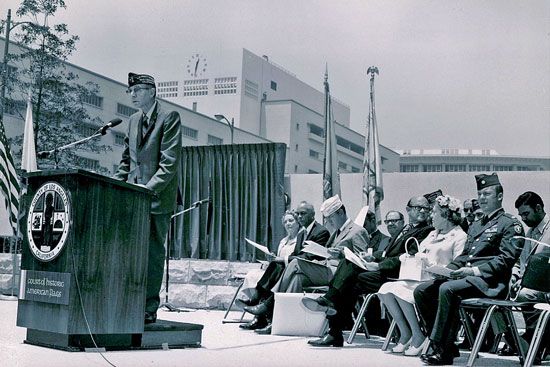


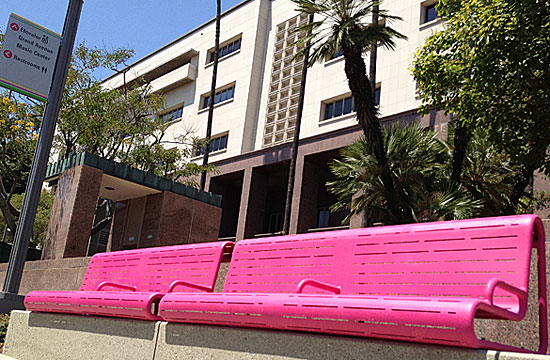







 405 bridge work causes a stink
405 bridge work causes a stink
